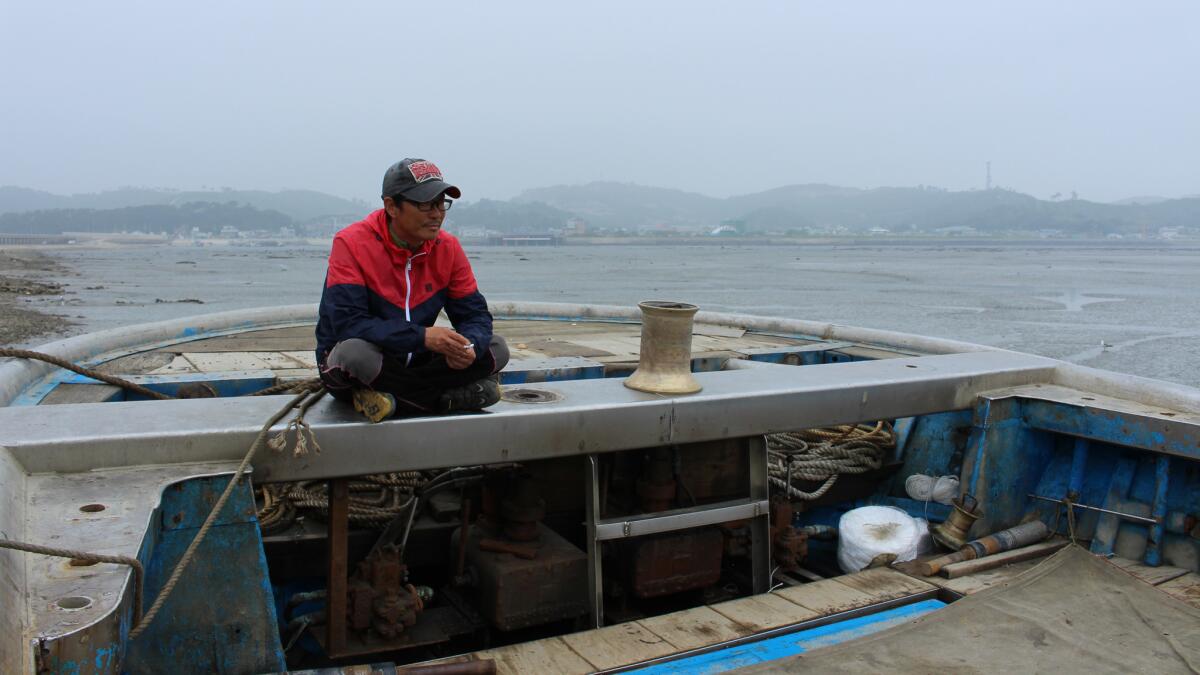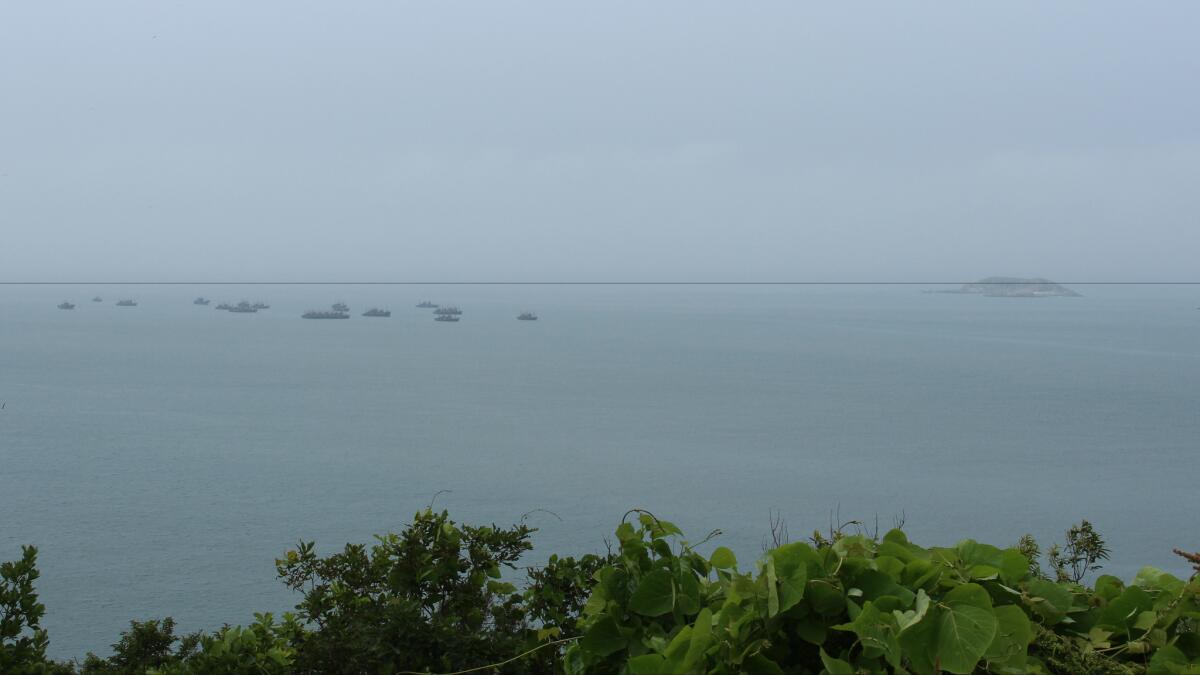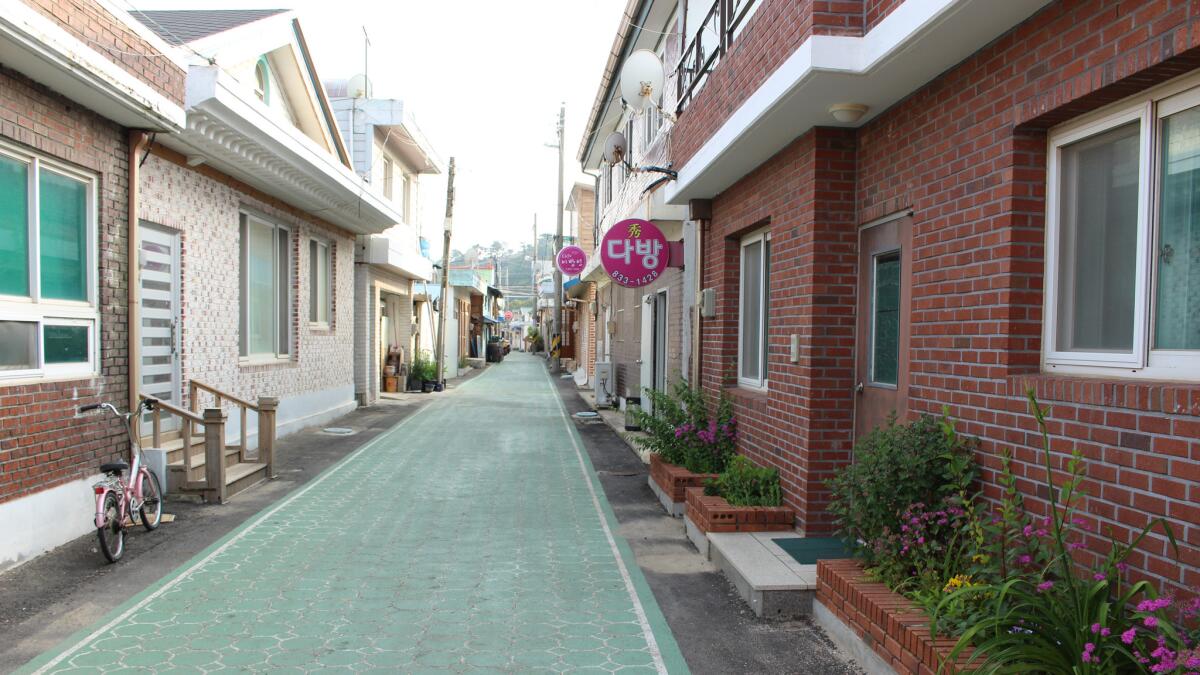Ramshackle South Korean island faces a threat more urgent than North Korea

- Share via
Reporting from Yeonpyeong Island, South Korea — Park Tae-won has a salt-and-pepper crew cut and the leathery skin of someone who has spent his life at sea. Six days a week he pushes his creaky boat, covered in peeling sky-blue paint, out into the waters off this weather-beaten island.
He and his colleagues stay at sea for hours at a time, using rectangular metal cages to catch blue crabs, which later end up on restaurant tables throughout mainland South Korea. But these days, it is another tool, his cellphone, that has become crucial to his struggle to salvage his livelihood.
Park’s phone is full of dozens of videos of gray, rickety boats flying red Chinese flags. He takes the videos out of a sense of helplessness as he watches his hauls of crab drastically diminish because of illegal Chinese competition. He regularly sends the video to South Korean government agencies, hoping to create momentum to push the government to dispatch more vessels to shoo away the Chinese boats, which are prohibited from fishing in the area.
The Chinese vessels have been driven to the South Korean fishing grounds by declining stocks in their home waters. The result has been a dramatic drop-off in blue crab catches, leading local fishermen to fear for their futures.

Yeonpyeong is a dot in the waters where China and South and North Korea come together. It has a population of fewer than 2,000 and total area of less than 4 square miles, but feels even smaller, because its population is almost entirely concentrated in a small residential area near the port.
When returning from sea, Yeonpyeong fishermen dock their boats at the island’s main port, a concrete and asphalt space that smells of salt water and decomposing fish. After unloading their catches, the fishermen gather at one of the island’s few restaurants, a short distance down the road, to commiserate.
There, they sit cross-legged on the floor around tables covered in boiling pots of fish soup, using chopsticks to eat pickled vegetables while knocking back shots of soju, a distilled Korean liquor that is comparable to vodka.
Park said the fishermen are working longer hours and coming home with less. “Pretty soon, there will be nothing left,” said Park, 56, dressed in a salt-stained black tracksuit and chain-smoking cigarettes.
South Korea’s Ministry of Oceans and Fisheries announced on June 10 that the crab catch in April was 69% lower than for the same month last year. The ministry has also said that in recent years more Chinese vessels have been spotted in the area. In response, on June 10, South Korea dispatched navy speedboats to chase off Chinese boats near the coast.
Last week, some Yeonpyeong fishermen became fed up and dragged two Chinese boats to shore themselves. The Chinese fishermen were deported, but two captains face arrest in South Korea.
June is peak crab season, before fishing is suspended in July and August to allow the crabs to spawn. Amid the stiff competition, fishermen are trying to catch enough to last them through the off months.
The Chinese boats and South Korean coast guard play a testy game of cat and mouse. The Chinese boats travel in packs, moving to comparatively crab-rich South Korean waters, then scurrying into North Korean waters when the South Korean coast guard chases them, knowing the South Korean boats risk sparking a military clash with North Korea if they follow them north.
The waters have long been a hot spot in the simmering conflict between South and North Korea. In 2002, six South Koreans and an unknown number of North Koreans died in a battle that broke out when a North Korean patrol boat crossed into South Korean waters. In 2010, an artillery exchange with North Korea caused four deaths on Yeonpyeong.
With the situation getting more dire, Park has become a de facto spokesman for the fishermen. Throughout an afternoon interview at his seaside office, his cellphone rang constantly with calls from fellow fishermen. He took each call, often raising his voice and gesticulating as he complained that the government wasn’t doing enough to keep the Chinese boats out.
Park worries that the Chinese boats are doing permanent damage to the ecosystem he relies on, saying they use a method called bull trawling, which is illegal in South Korea. Bull trawling entails dredging up everything in the ship’s path and damages the seabed. “They take everything,” Park said. “Even the babies.”
Some residents of Yeonpyeong believe the Chinese vessels pose an existential threat to their lives on the island. “People here have always lived from their boats, and now they’re going to be left with nothing. It’s scary,” said Yang Yoo-seong, 59, a construction worker specializing in pipe installation.
Yeonpyeong has had its existence threatened before. The island was almost completely evacuated for weeks after the 2010 shelling brought the peninsula to the brink of war.
Song Young-ok, the middle-aged owner of a small guesthouse, remembers that day well. “The sound of the explosions was horrifying. We ran for cover and prayed,” Song said. The shells fell just a few hundred feet from the guesthouse Song operates with her husband.
Shells hit the island’s main commercial district, a narrow street lined with cafes and restaurants. Six years later, the street has no visible scars. The rubble has long been swept away, and reconstructed buildings gleam with fresh coats of paint.

Given its history and proximity to North Korea, Yeonpyeong has a large military presence. Truckloads of soldiers rumble along the otherwise quiet streets, and the north of the island has several military observatories that face North Korea.
Amid the barbed wire and rock-face cliffs on the island’s northern rim is a small museum that details the exhaustion of a seafood staple by overfishing. Yeonpyeong was once a hub for yellow croaker, a small fish that was the island’s lifeblood until stocks all but disappeared in the late 1960s. An exhibit explains that the people of Yeonpyeong turned to blue crab fishing after the yellow croaker ran out.
On a recent hazy, humid afternoon, just behind the museum, a cluster of more than a dozen fishing vessels flying Chinese flags floated off the coast.
“We’ve always found ways to get by,” Song said as she walked in a park just outside the museum. “But I don’t know what Yeonpyeong people will do when all the crabs are gone.”
ALSO
Steely Dan with strings at the Hollywood Bowl?
President Obama: Orlando shooting was ‘act of terror and an act of hate’
Santa Barbara fire explodes to 1,700 acres and again closes Highway 101
Borowiec is a special correspondent.
More to Read
Sign up for Essential California
The most important California stories and recommendations in your inbox every morning.
You may occasionally receive promotional content from the Los Angeles Times.










